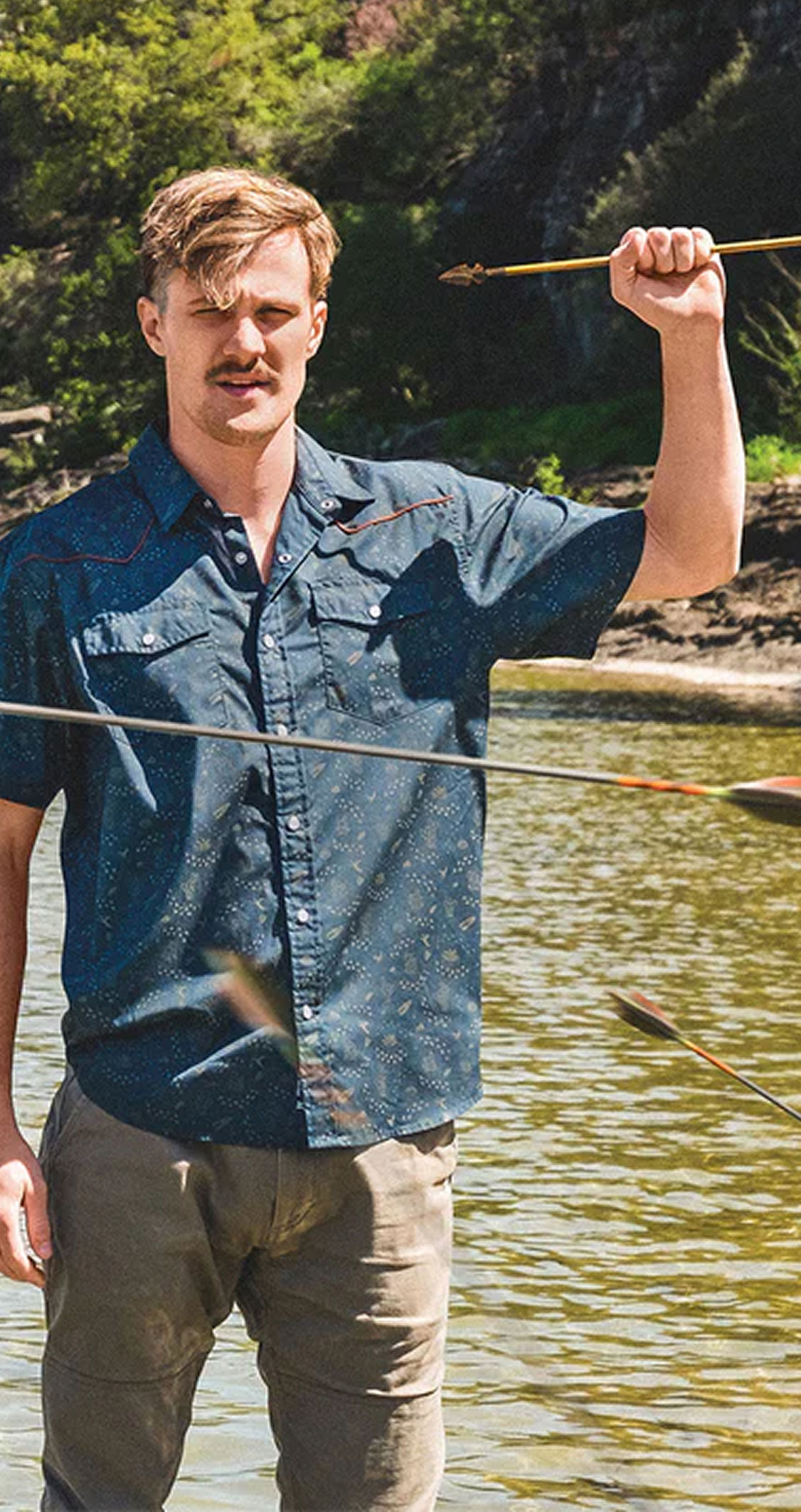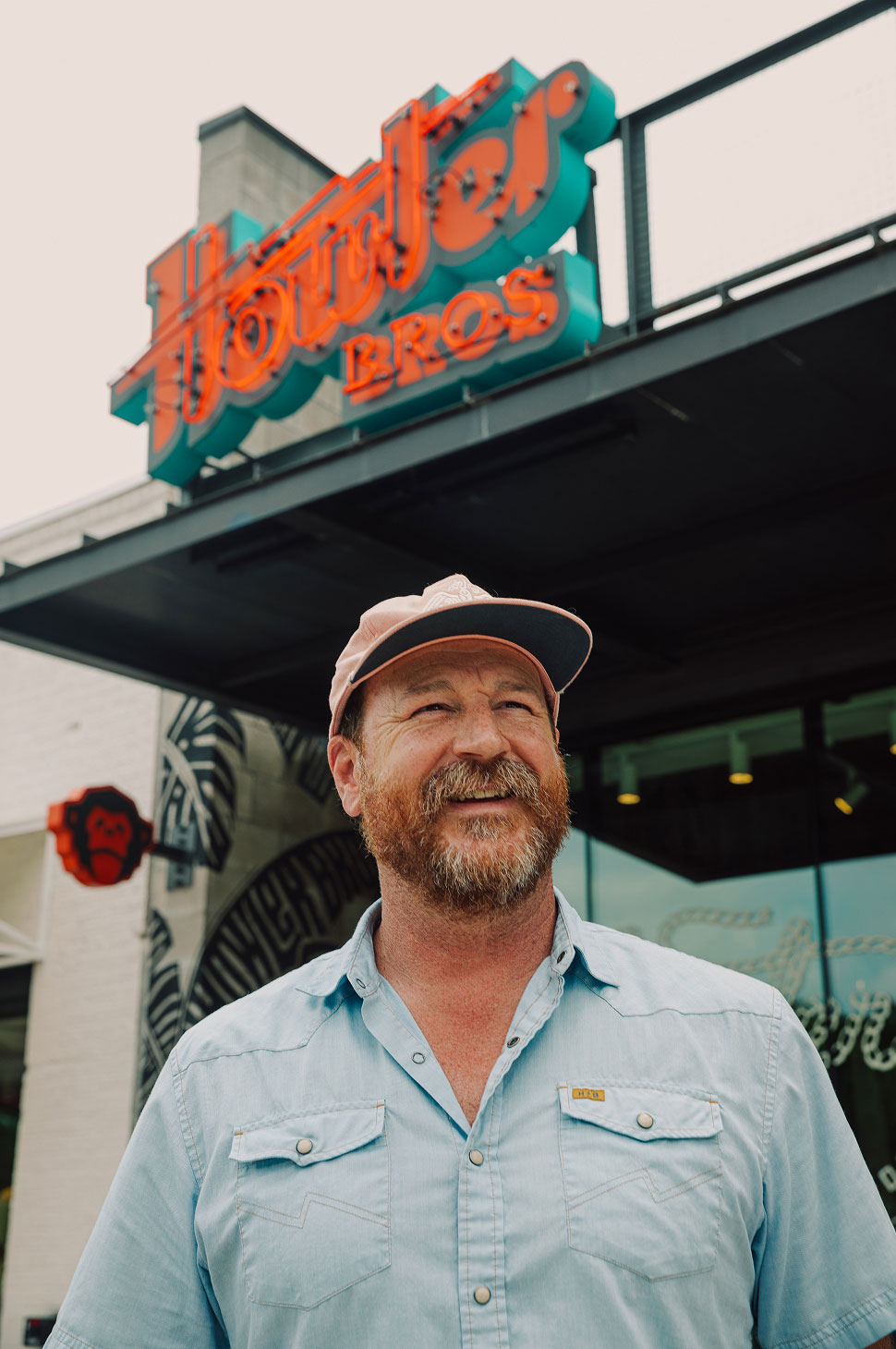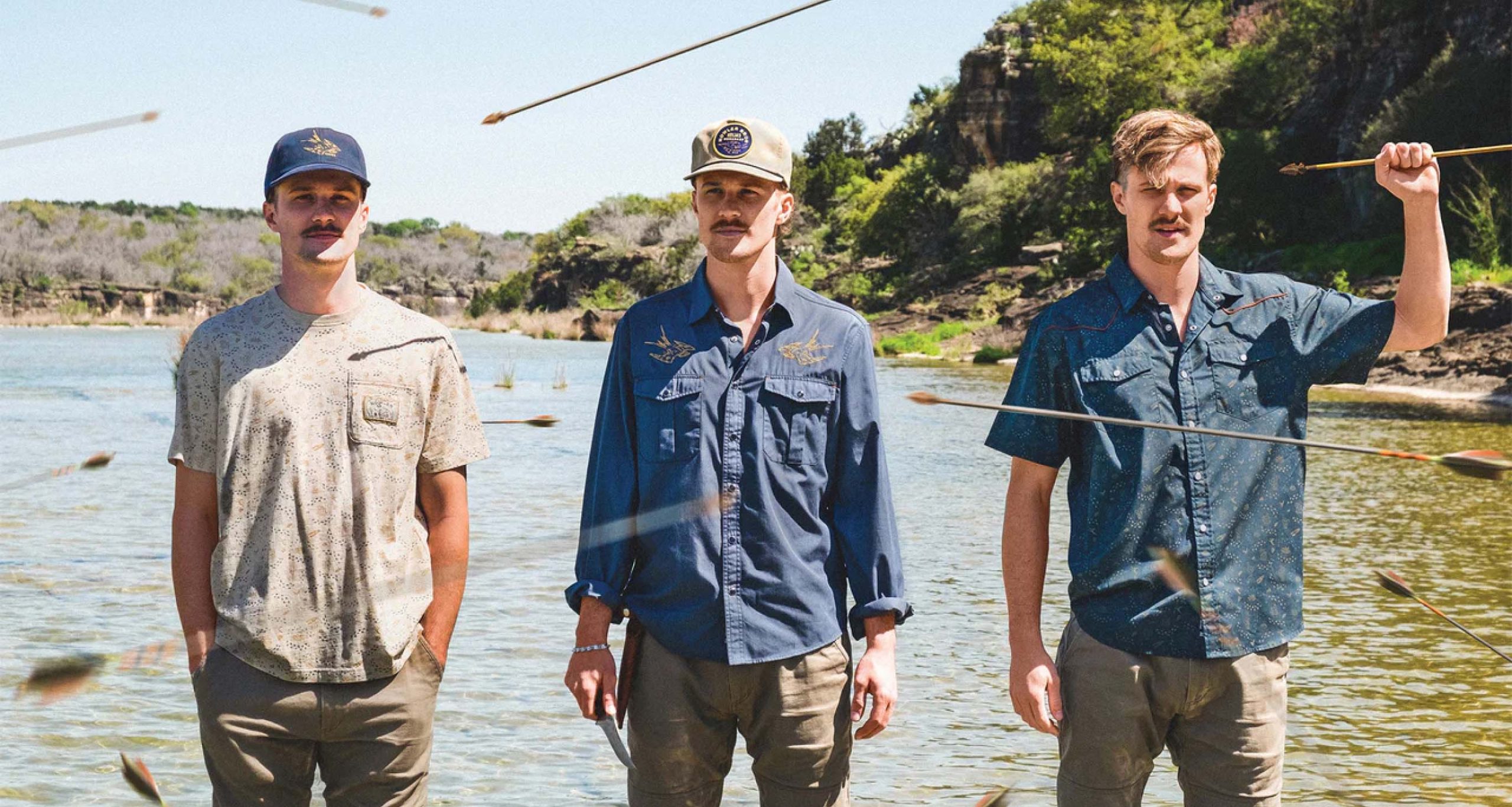
Love ‘em or hate ‘em, you’ve got to admit that Howler Bros are a force to be reckoned with. I happen to fall into the “love ‘em” camp because I’m a big fan of anyone who sticks to their guns, and that’s exactly what Rick Wittenbraker and his team have been doing for more than a decade now.
Their eye-popping designs, hardcore commitment to quality at every step, and Texan bravado are just a few of the reasons they’re often imitated, but never replicated. I dig that.
On a humid, sunny Thursday in Austin, I had the chance to sit down for lunch with Rick—the Vice President of Business Development and one of Howler’s first employees—to shoot the proverbial shit. Over the ambient hum of traffic on South Congress, we talked about the things that interest me most about this unicorn of a company, from how they generate creative ideas to which ideas don’t make the cut. It surprised me to hear that both answers are equally important.
It also surprised me how many times music came up during our conversation. You wouldn’t think an apparel brand would be so musically minded, but it makes sense when you walk into their stores. You can almost hear the pedal steel and lively snap of the snare when you look at one of their shirts—and that’s no accident.
I’ll let Rick explain.

Levi Goode: How’d you make your way to Howler Bros?
Rick Wittenbraker: A mutual friend introduced me to the founders, Chase Heard and Andy Stepanian. The three of us went to lunch and we just hit it off. I was at Yeti at the time, which isn’t exactly the same industry, but there’s a lot of overlap. Through that meeting, we became fast friends, and eventually we were having beers every six weeks or something.
At that time, Yeti was on this rocket-ship trajectory. It was just exploding and we couldn’t make products fast enough. Not that I had all the answers, but I had just been in the industry a little bit longer than Chase and Andy. We’d see each other at the same trade shows and I’d end up hanging out with them more than anyone. Eventually, they asked me to be on the advisory board, which really meant we were having beers once a month [laughs]. Long story short, it snowballed from there. Eventually, I came on the team to help shape the brand. I've been here for over 11 years now—I think I was the fifth employee.


“I would say Austin is part of our DNA. It has this history of being a town that has always embraced funky weirdos and category busters.”

LG: I’m not sure if y’all consider yourselves a “Texas company,” but I think most people see it that way. Why has Howler made their home here?
RW: There’s so much this state has to offer, both in the geography and the terrain and all the different ecosystems. It has a huge coastline that's often forgotten. All of those things—and the activities they provide—inform what we love to do as a brand. Specifically, I would say Austin is part of our DNA. It has this history of being a town that has always embraced funky weirdos and category busters and it's been a very collaborative place for a long time. It's not just a big city. It's grown a lot, but it’s had an awesome creative community for many years
LG: That’s a great point. It probably says something that Willie, Townes, or Waylon would look spot-on wearing a Howler shirt in the ‘70s. Do you think Austin has informed the aesthetic?
RW: Totally. It has influenced who we are, how we act, how we carry ourselves, and how we talk to our customers. It also provides a lot of liberty because it’s such a mashup. We take a lot of inspiration from vintage Western culture, but we also take a lot of inspiration from music and surfing and all these other communities. If you lived in the city that was more “straight and narrow,” it probably wouldn’t have ended up the same way.
LG: Eccentricity isn’t exactly rare around these parts.
RW: Shit, it’s almost a requirement.

LG: Speaking of eccentricity, I heard you use the term “Howlery” in an interview to describe if an idea makes sense for the brand or not. Care to explain what that means?
RW: Good question [laughs]. That was actually Chase and Andy’s term, but it was without a clear definition. It basically meant what felt right. It’s common to hear us say “that’s Howlery” or “that’s not Howlery enough.” It’s something we’ve worked hard to define because it is difficult to define. Some of it is the aesthetic, some of it is attitude and demeanor, and some of it is character. As we continue to grow, it becomes more important to define it.
One of the ways we do that is to make comparisons. If we were a beer, we’d be this beer. Or, we would not be these beers over here. It’s not an exact definition, but it helps frame up a state of mind for whoever is trying to wrap their head around the brand. One of the biggest things that I’m a massive believer in is defining the “no” list and the stuff that is outside of our circle.
LG: What are some specifics?
RW: Several years ago, we made this book that comes with a vinyl record, and the book is actually the liner notes of the record. We made a quiz to go along with it with a custom scantron. For example, it may have two pictures of Willie Nelson and the employee will have to define if we’re “Red Headed Stranger Willie” or “Stardust Willie.” There’s no right answer, but it gets you thinking.
“I try to show people what a brand is. It’s sure as hell not a logo—that drives me insane—but it’s also not a product and it's not a company.”


LG: I like to think of myself as “Shotgun Willie.”
RW: Solid choice. With all of this stuff, I try to show people what a brand is. It’s sure as hell not a logo—that drives me insane—but it’s also not a product and it's not a company. The brand is the character of the company. Think about a movie. The character is written, they give the actor a backstory, a personality, where they're from, and maybe their accent. Maybe they have a limp, who knows. The actor has their interpretation of the character, but that character is defined beforehand.
My favorite example is always Han Solo. He’s this smart ass troublemaker. He owes a lot of people money. He’s kind of a derelict, but you also kind of love him because he’s this badass who doesn’t have a perfect record.
LG: The kind of guy who replies, “I know” when someone says, “I love you.”
RW: Exactly. He has this attitude and swagger, but also he's always on the run from some debt collector. All of that is written and baked in. We know those things about Han Solo and then Harrison Ford brings him to life. With regards to Howler, Andy put a lot of energy into the character ahead of time, trying to craft the personality. One of my challenges when I joined was trying to put that on paper so the rest of the folks coming in the future would be able to then take it and run with it.

LG: I think people see it as a limitation, but once you nail that down, it creates a lot of freedom.
RW: It’s an empowerment, one hundred percent. I think it’s a limitation when you don't have your character defined. It’s empowering because your team can get into character. When I’m responding on social media, I know how to act. I’m not acting as Rick, I’m acting as Howler. We know what that tone is, we know what that attitude is, we know the slang, and the shit that we’re going to say versus Rick or you or anybody else.
LG: One of the main reasons I wanted to chat with you was to talk about ideas. In a way, you could say that’s Howler Bros’ main product, and I’d love to hear about how an idea does or doesn’t come to life.
RW: Our creative process usually starts with some sort of big idea or inspiration, just like most people. Maybe we want to feature a bird in our next line or celebrate life on the coast. Then, it’s the process of pulling everything we can think of that relates to that idea. We do a really good job of taking those ideas and iterating—here’s what this idea could be.
I’ll give you an example. Last spring, one of those ideas on the table was the caracara, sometimes called Mexican eagles. It’s a super cool bird up and down North America, but here in Texas, it’s more prevalent along the coast and farther south. So, what do we do with that? Our team comes up with all these ideas, and we refine, edit, and iterate to a point where we really love where it’s going. We did an embroidered caracara shirt, an all-over print, and we put a lot of effort into creating the print and working with artists on it. We then extrapolate that print onto shirts, board shorts, t-shirts, and all this stuff. It was just one little idea that ended up coming to life in all these different products.

“People go through phases. That’s fine, I think. But when that’s a Slim Aarons photo, or when it’s a Jimmy Page lick on a Led Zeppelin song, it can’t be anybody else. That’s what we’re going for.”


LG: What sort of ideas don't make the cut?
RW: There are a couple ways it doesn’t make the cut. One way is that we love the idea, but the artwork is not there yet or the design of the embroidery is not quite right. We won’t throw it away forever, but it needs another crank or two of iterating in the shop. Sometimes, we nix an idea because we just have too many ideas. Only the strong survive. We had one a couple of years ago that was a hammerhead shark, and it was really cool. People would’ve loved it. The idea was great, but the design wasn’t quite there, and it needed more work. And then sometimes you have some where you like the idea, but you just can’t execute it within our brand’s voice. It could be the topic, the subject, a color, whatever, and it just feels forced or it feels like it's not us. One of the things we do all the time is put tape over any logo or name and say, “Okay, does that look like us?”
LG: That’s interesting, photographers and artists do the same thing.
RW: For sure. You know when it’s Slim Aaron's photo or Ansel Adams’ photo. Music’s a lot like that, too. It doesn't mean you can’t experiment and do other shit.
LG: We saw how Dylan’s gospel phase turned out…
RW: [laughs] Fair enough. People go through phases. That’s fine, I think. But when that’s a Slim Aarons photo, or when it’s a Jimmy Page lick on a Led Zeppelin song, it can’t be anybody else. That’s what we’re going for.


LG: My favorite thing about Howler Bros is that y’all design everything from the ground up. I’m sure it isn’t easy, though, so why put up with the headache?
RW: I think of it like music. Any good musician wants to share a song exactly the way they envisioned it, not 90% of the idea. They’re not piggybacking off someone else’s guitar or drum beat. They’re not just putting lyrics on top of a song. We want to write the song from scratch because it means something to us, and we want to go through that process of writing the drum piece, the guitar piece, the lyrics, the whole shebang.
It’s a big part of what we do and how we do things. There are a lot of brands out there who maybe don't care as much about doing it the way we do it. And that’s fine. There’s nothing evil about it. It just doesn’t have the same level of intentionality. It doesn’t have the same care and it doesn’t have the same originality and creativity.
LG: People forget about the value of the process, even if that process gets to the exact same place as someone who took a shortcut. If you took a helicopter to the top of Everest, you’re in the same spot as the guy next to you who climbed up, but he had a much different experience.
RW: Totally. That's a great example.

LG: So there’s got to be value in placing every stitch, even if the shirt ends up looking the same as if you slapped a logo on someone else’s work.
RW: Chase is incredibly talented at what he does, and we’ve built this badass team around him that’s really good at supporting the greater vision. But, every stitch remains important to us as a company. It’s something we care a lot about. We also care a lot about not phoning it in. Back to your earlier question, we kill shit all the time because we feel like this isn’t original enough, or it’s not us.
There are a lot of brands out there that have ordered from us, and then they come out with something that looks a lot like it the next season, which is super annoying. I don’t care if we’re supposed to be flattered, it’s annoying. But I think in some way it’s sort of this cheap quick win and they’re never going to have the same depth of satisfaction. They took a helicopter to the top.
I also want to point out that we’re not for everybody, and we recognize that. We want to be with the right customers and find the right people. Now, hopefully there’s a lot of them, but it's never going to be all of them.
“It’s all our invention. We do whatever we want. It’s almost like our wacky EP release. It doesn’t have to fit on the album.”
LG: It seems like sticking to your guns is a common motif for Howler Bros.
RW: I see it as heeding our own call, really. The team we’ve assembled really thrives on that and loves the opportunity to crank out new stuff. We have our core offerings, and that requires creativity and originality every time. We reinvent that every six months. We also have all these special releases that tend to be collaborations and partnerships. Then, we have our own internal things that we launched called “Mutations,” which are our wilder, freakier endeavors that we just want to make just because. It’s not going to be for everybody, and we’re going to make it in smaller batches. It usually comes with some whole backstory and whatnot.
We just did one a few weeks ago based on the Bermuda Triangle and the lore behind the Bermuda Triangle. We created all these products based on it, and then we made up this whole story and film around the origin. It’s all our invention. We do whatever we want. It’s almost like our wacky EP release. It doesn’t have to fit on the album. We’ve done another release about a legendary mythical beast in Idaho called the Swan Valley Monster. There’s this lore up there and all these sightings and reports and crazy-looking drawings. We just like doing that shit. It’s a different set of tools, and a different set of requirements. The brief can be tougher to satisfy, but when you do it right and it works, it’s freaking awesome.


LG: I guess if y’all are doing what you want to do, the creative drive is always there.
RW: That’s one reason, and the other is that we like to work together. I always go back to the name Howler Brothers, plural. We don’t have to be from the same parents, but we have a friendship and something that means something and that matters to us. It matters how we treat people. It matters how we treat our teammates, our ambassadors, our retailers, and our audience. It’s not just for us. It’s a “we” thing. Like I said, it’s called “Brothers” for a reason.
Photography by Steve Schwartz
